By Evan Fry

Sections of this article:
Watch collecting is less modern than you might think
Collectors Watches: What makes a watch collectible?
- Quality: How well the watch is built
- Aesthetics: were the designers trying
- Brand identity: who are these people?
- What is the historical significance?
UnconstrainedTime belongs to collectors
If you’re anything like us at UnconstrainedTime, or if you’re reading this at all, you are (or are about to be) deeply entranced with the world of watches and watch collecting. And we don’t blame you. It’s an industry filled to the brim with real history, mind-blowing innovation, and passionate communities willing to discuss, debate, and experience it all with you. And with new technology and insights, now is debatably the best time to be a collector. Never in history has information been so readily available for not only watchmakers but for anyone interested in learning and educating themselves on any aspect of this industry. Collectors’ watches are now more diverse and personal. We can also enjoy the luxury of shopping for watches that are being sold on the other side of the world. We’re no longer limited to what’s in our area, and that opens up so many possibilities that enthusiasts of old couldn’t enjoy or comprehend. Now more than ever, it’s possible to find watches that truly inspire and excite the individual.
This is the time to celebrate your uniqueness. In this article, we’ll dive into the history and world of watch collecting, and discuss what exactly makes the watches we love so lovable, as I throw in my thoughts and opinions along the way, and stay until the end to hear why I think UnconstrainedTime belongs in any collection.
Watch collecting is less modern than you might think
While it’s easy to assume that the concept of watch collecting is as old as well, time, the idea of watches being anything other than a tool is a concept that has only recently been embraced, save the odd aristocrat here and there. Watch collectors have technically existed since the beginning, but the scale and publicity that we know watch collecting to have today is a new phenomenon. I aim to discuss both the older origins of watch collecting and how collecting and the industry as a whole has only recently been completely rebranded.
So what about those early collectors? What kinds of people saw the beauty of the craft before it was cool? Well to be completely candid, watch collecting began through a need rather than an appreciation for the small complex devices. As much as we’d all love the story to be about a forward-thinking and passionate collector who showed the world how beautiful the timekeepers are, the evidence points more towards a less romantic group of origin: the clumsy aristocracy. Allow me to explain. In the early days of watches, they weren’t worn on the wrist but were attached to a chain in the form of pocket watches, with the first pocket watches being made without a chain. If you’ve ever held a pocket watch, or even seen one, you’ll know that more often than not they have a very smooth and rounded shape. While that makes them comfortable to slip into a pocket, it took early users a little getting used to, and accidentally dropping them was embarrassingly common. Unfortunately, due to the incredibly fragile nature of early pocket watches, a short fall is a guaranteed death. Paired with the fact that they were about as accurate and reliable as a drunk trying to read a sundial, the ownership of multiple watches quickly became imperative. It sounds like a pretty bad deal now, but considering they were invented in the 1500s, they deserve some slack (just not too much or you’ll drop it).
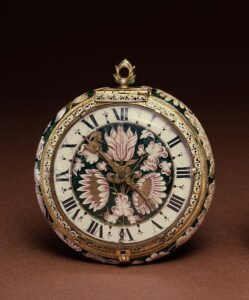
“Knowing how often watches broke, do you think they only owned one?” (Ariel Adams, “Why There Have Always Been Watch Collectors”, A Blog To Watch.)
On the plus side, this pushed watchmakers to constantly improve their craft, slowly building and developing their designs to be more accurate, robust, and visually striking. Watches became real tools, and with that, they also became more desirable. Clients also became more familiar with their local watchmakers, and instead of constantly repairing dropped watches, they could focus their attention on creating custom pieces for their clients, greatly strengthening the bond between watch and customer. With collectors’ watches becoming more about the craft and less about the need to tell time, more people began to flock to the hobby. This concept of custom watches for clients with an artistic appreciation still inspires both collectors and watchmakers to this day and is something we at UnconstrainedTime find fascinating (more on that later).
Even with the invention and widespread use of the wristwatch, it took a long time for collectors to shift their focus away from traditional pocket watches. I don’t exactly blame them. Pocket watches are the original mechanical and portable time-telling devices! They also sported far more complications, and were much more artisanal and luxurious, often being made out of gold, with custom hand engravings on the case. Compared to early wristwatches, they were far more desirable and intrinsically interesting. Unless the watch was made for a person of significance like royalty, it seems early collectors couldn’t be bothered. This trend continued far past the invention of the wristwatch in 1810 (made for the queen of Naples at the time by Abraham-Louis Breguet) and didn’t see a major change until what is known as the “Quartz Crisis” in 1969.
An Industry in Peril
The Quartz Crisis is a deeply fascinating time in watch collecting history, and it’s known as one of, if not the most significant turning points in the industry of all time. For those who don’t know, the Quartz Crisis was the period after the first quartz-regulated watch was introduced to the public, where the popularity of the movement almost ended the existing mechanical watch industry. Quartz watches are far more accurate than any competing mechanical movement, and much cheaper and more durable. It made mechanical watches effectively obsolete. Collectors’ watches were either hoarded or sold as people tried to preserve the past or liquidate the assets. During the 70s, watchmakers collapsed left and right as a result of the rising popularity of quartz watches and the declining need for mechanical ones. Not just the little guys, either. Essentially every watch brand that didn’t go quartz was facing some serious issues. They just couldn’t compete with what the quartz movement had to offer.
“Between 1974 and 1983, Swiss watch production had been cut in half, falling from a record 96 million units to 45 million.” (Catelyn Bazemore, The Quartz Crisis, Unwound)
Thankfully for us enthusiasts, they found a way, and that way completely changed how we collect watches today, quartz or mechanical. They realized that they could no longer offer themselves as a well-made essential tool, so in addition to several of them merging to be sister companies, they remade themselves to be viewed more as items of heritage and luxury. They gave themselves a reason to be collected. Now enthusiasts had a reason to own more than one watch. You had watches for accuracy and daily use, and watches that were status symbols and more artistic. Today, quartz and mechanical watches coexist and are both seen as acceptable and desirable by enthusiasts and the populace at large. Collectors’ watches are now equal parts mechanical or quartz. Even companies considered to be the most luxurious and traditional still use quartz movements in some models.
After the dust from the Quartz Crisis settled, watch collecting began to grow exponentially. Now everyone, no matter age, gender, or net worth could own one if not several watches. For the first time, watches were being made especially for children. Your watch was no longer a serious tool used to organize your life, but a statement of fashion and self-expression. Watches became fun! Brands started to experiment with designs, materials, and colors. There was a breath of new life for the industry as well as enthusiasts. I can think of no better example of this than Swatch in the 80s. By making watches almost entirely out of materials like plastic, they invented the concept of a disposable watch. When your Swatch breaks, you don’t fix it. You just buy a new one! It costs nearly nothing and allows you to change up your style. This allowed them to pump out a massive catalog filled with crazy colors and expressive designs. They were the first watches that were purely meant to be collectible. Many people who wore Swatches as children grew up and became more immersed in the world of watches because of their fond and nostalgic memories of their Swatches.
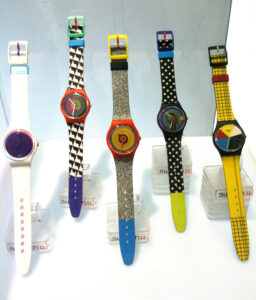
The picture above shows the playfulness of Swatch and the expressive designs they still sport to this day.
Today, watch collecting is more popular than ever. With tools like the internet giving us the freedom to learn and discuss all things watches, more and more people are flocking to the hobby. I was first exposed to watch collecting by hearing musicians talk about their collections online. I was fascinated by the different styles and brands, as well as just how complex watches are. Social media gives companies and collectors alike a platform to share and learn about watches together. Without the existence of those platforms, I wouldn’t be the person I am today.
Brands are starting to push the limits of what’s possible, whether it be technological innovations or designs that are bold and original. No longer are we confined to what artisans can do by hand. This explosion of variety and options has pushed watch collecting to an unprecedented level, even as watches become increasingly obsolete. I personally know people with watch collections of eighty or more, investing considerable time and money into the passion they have for wrist-worn timepieces. Such enthusiasm at the scale we know today is a very recent concept. At UnconstrainedTime, we too have been inspired by this new age in watchmaking, and we’re dedicated to being more than just another watch brand.
Collectors Watches: What makes a watch collectible?
In this article, I’ve talked a lot about how the concept of collecting watches became what it is today. I believe it’s important to know and understand the history of how before we dive into why. Now that we have that knowledge, it’s time to look at what exactly collectors look for in a watch, and why these watches are separated from the crowd. I’ve taken the liberty to separate the most important and sought-after qualities into a few different categories for us. Today we’ll talk about quality, aesthetics, brand identity, and historical significance. There are endless reasons why people buy watches, but these four are the ones that I (and most others) as an enthusiast primarily focus on when looking for the next addition.
Quality: How well the watch is built
I’ve decided to start with quality because it’s a relatively simple concept. However, there’s more to it than meets the eye (literally and figuratively).
The first aspect of quality is the most obvious: if the watch is well built. As someone who loves watches, I want to know that I can wear it with confidence that it won’t disintegrate on my wrist. When you hold the watch in your hands, you should be able to feel its longevity and be proud of it. The only visible seams should be around the case back and maybe the bezel, depending on the watch’s style and purpose. The watch should feel dense to some extent. You should get the feeling that you’re holding a strong and solid object, as opposed to the feeling of holding something fragile like an egg or a child’s poorly built Lego creation. Simply put, the construction should evoke a feeling of legitimacy and thoughtfulness.
Next are the materials used. When it comes to the industry standard, 316L stainless steel is the most commonly used. However, alternative materials are becoming a lot more popular, and brands are becoming more creative in their use. These materials include but are not limited to bronze, titanium, carbon fiber, aluminum, sapphire, and even wood. Precious metals are some of the most historically traditional, and consist mainly of gold and platinum, although you might find a silver watch here and there. Collectors’ watches are often of many different materials, as a diverse collection is desirable for the majority of enthusiasts. When choosing a watch that is the summary of who you are, it’s important to consider the wide variety of materials and each of their characteristics to determine what will work best for your lifestyle and celebrate your uniqueness. I personally have been more and more interested in bronze, as it features a lovely rose gold/copper color, is more uncommon than steel, and it tarnishes and patinas in a way that only adds more beauty to the piece. I feel that those qualities fit my personality and lifestyle, and other materials will appeal to people similarly. Many people are attracted to titanium because of its strength, lack of weight, and dark gray hue.
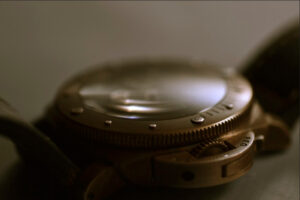
Bronze is a popular alternative metal (as shown on the above watch by Panerai)
The final quality consideration for today is the value proposition, or what you’re getting vs what you’re paying. When I peruse different watch options, I always consider the price of the watch in relation to the amount of quality it offers. I want to know that what I’m getting is not only a well-built watch but is offered at a price that justifies its quality without being excessive. No one wants a watch that’s poor quality and too expensive. On the flip side, no one should expect a watch that sports luxury quality to be offered at an unreasonably low price. There’s a sweet spot where the price is a bargain for what you’re getting out of the quality. Other factors like intense quality control, customization, and rigorous testing also make an impact on the value proposition.
Aesthetics: were the designers trying?
The aesthetic appeal of a watch is one of the most important but also highly subjective aspects when it comes to collectible and desirable watches. To me, it’s also the most fun and exciting part of a watch. I love unique watches that bear strong statements and personality. Watches are more than just telling the time. They’re accessories that communicate to the world who you are and what you value. Watches boast a unique form of self-expression that other types of accessories just can’t quite touch.
In this era of watch history, we see two very opposite aesthetic choices that companies fall somewhere in between. On one end, you’ll see watches that are very closely, say, “inspired” by other popular watch designs, with the company’s logo slapped on the dial. These watches are known as homage watches, with some of the less original often being dubbed “clomage” watches, as a combination between clone and homage. These watches are good placeholders for those who are priced out of the originals, or for those who aren’t sure if the design is for them and need a less expensive trial run. Unfortunately, at least in my opinion, homage watches aren’t good for much else. I prefer watches where the designer poured time and energy into making something new and different. Most seasoned collectors eventually fall into this category, since designs that are constantly being used eventually become boring and repetitive.
On the other end, there are watches bursting at the seams with bold originality, pushing what’s thought as normal or even possible. Designs that are not only new and fresh, but are crafted with purpose and even emotion, not unlike great paintings of old. These are the watches that are seen as truly collectible pieces. Enthusiasts (me included) love designs that are thought-provoking. Watches that tell stories through their artistic characteristics will always be held in a higher regard than watches that copy someone else’s ideas. Throw in good quality, and you have a recipe for a truly amazing watch.
A perfect example of artistic uniqueness is the Jacob & Co. Astronomia Tourbillon:
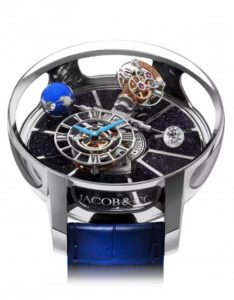
Brand identity: who are these people?
When you buy a watch, you’re buying an item that was made by someone for a reason. You’re buying not only a device for telling the time, you’re buying the people behind it and what they’re trying to communicate. When looking for a watch, research the brand. What is their story? Why did they start? What’s their mission? Every brand, no matter how new, has a story to tell. Some try to hide it, others are proud of what they represent. Those are the brands that collectors are drawn to. No matter how much bang for the buck a watch might offer, if it comes from a brand motivated only by profits and happy investors, it’s difficult for enthusiasts and me personally to fall in love.
On the flip side, when a watch is designed and made with great thought and consideration, the watch becomes more than just the sum of its parts. It becomes a tangible result of years of hard work and passion from an individual or a group who genuinely cares about the watches they are putting out into the world. Watches that are made by collectors, for collectors are almost always the best in the market.
What is the historical significance?
I’ve said it before and I’ll say it again, we watch enthusiasts are quite the bunch of history buffs. Ask any of us about our favorite brands or models, and we’ll most likely dive into an unsolicited crash course lesson on the history of said brand, and why that makes them speak to us. Vintage pieces have made a major impact on collectors’ watches. When you are involved with an industry that is so deeply tied to many major aspects of historical significance, it is difficult not to be swept away by a fascinating torrent of dates, people, places, and events. One of the most famous examples is the well-loved Omega Speedmaster (below). Collectors far and wide will leap at the chance to regale you with the story of how it became the first watch worn on the moon. It’s a cool story! Who wouldn’t want to wear a watch whose sibling went to the moon?
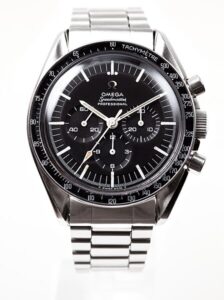
Another prime example is what’s known as the “Paul Newman” Rolex Daytona (below). What was originally a shunned and unpopular dial variation of the legendary Daytona became one of the rarest and most sought-after watches of all time thanks to the gifting of the watch to actor Paul Newman from his wife. The gift was inspired by Newman’s love of racing and was used countless times while on the track.
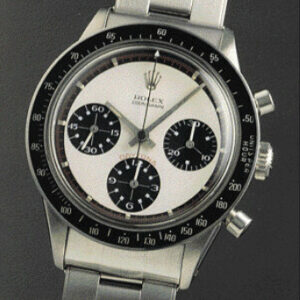
But watches don’t have to be worn on the moon or by celebrities to be historically significant. If a watch pioneers a new conceptual design or complication, or if the watch uses special technology, it is also historically significant, even if it remains unknown for the majority of its life. A brand doesn’t even have to be old to be historically significant. Richard Mille, an incredibly luxurious and highly coveted Swiss watch brand, didn’t even release their first watch until 2001. Even more recently, a brand that has quickly become one of the most beloved microbrands called Studio Underd0g (I promise the zero is not a typo) was officially launched in 2021. Both brands have already made history, and we hope will continue to do so.
UnconstrainedTime belongs to collectors
In a world over-saturated with the same handful of watch designs, it can be disheartening if you’re looking for something new and unique. Oftentimes, many collectors’ watches are very similar to each other. It’s not that the other designs aren’t good, and they certainly have their place in the industry, but to many collectors, they feel repetitive and even a little boring. On the other hand, watches that sport designs with an artistic level of thought and personality are often astronomical in price. We’re here to not only fix that problem but to do it in the coolest and most collector-centric way possible. With our completely original designs, we’re building a brand that’s not only making high-quality watches but also works of art. For anyone looking for the fearless originality the industry so desperately needs, we are a dream come true. Using that artistic focus and quality mixed with unique materials and a mission to make history, UnconstrainedTime belongs in every enthusiast’s collection. It’s time to celebrate your uniqueness . . .
Don’t miss our launch!
. . . subscribe here to receive notifications for early access to our small, numbered releases, exclusive creator insights, and behind-the-scenes glimpses of our artistic process before they’re shared anywhere else.

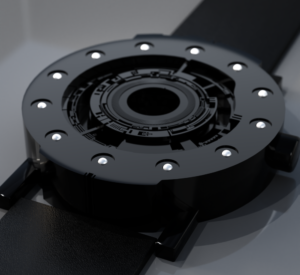

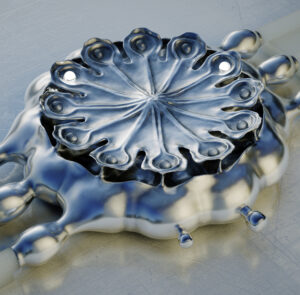
Leave a Reply